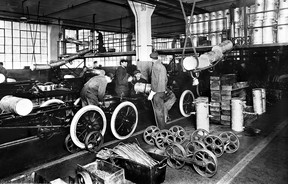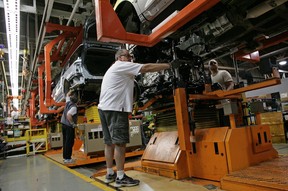Motor Mouth: Ford's 'Universal' EV platform to underpin US$30,000 pickup
There's more to the automaker's "Model T moment" than just a new platform, though—it says it's completely reinventing how it assembles cars

Article content
Depending on who you’re listening to — CEO Jim Farley or Ford’s marketing department — it’s either Ford’s “Model T moment” or a “$5-billion bet on America,” the first line, of course, directed at an entire nation for whom America’s first truly mass-produced vehicles remains a legend, while the second, one presumes, is aimed at an audience of one (and a few of his closely-allied sycophants).
Either way, both are huge statements, not the like of which will be forgiven as normal marketing hyperbole, should the whole shemozzle turn out to be no more than a few altered work stations and more robots on the assembly line. So, the big question on everyone’s lips — and I do mean “everyone,” as Ford has been pumping this announcement up relentlessly for the last 10 days — is this really a monumental revision of how Ford builds its cars?
The answer: not sure. Farley is talking a pretty good game, and some of the announcements are fairly dramatic. Is it as big as the auto industry’s first moving assembly line, the one the famed Model T rolled off 115 years ago? Nope, it isn’t. Could it be as game-changing as Toyota’s “just-in-time” manufacturing? For Ford, maybe. Will it have as profound an effect on Ford’s fortunes as Farley portends? Well, it certainly could — and sorry for blabbing the most titillating news right from the get-go — if, as promised, the end result really is a mid-sized four-door fully-electric pickup that costs just US$30,000.
How Ford’s EV assembly revolution works

Though few details are available yet, Ford’s “Universal Vehicle” — Farley is not lacking in taglines for his revolution — is an extension, a progression if you will, of Tesla’s “unboxed” assembly process. Instead of a linear assembly line that sees a bare frame start at one end and bits added all along its meandering route until a fully-clothed car pops out the other end, “unboxed” sees much larger sub-assemblies coming together in a more complicated, but faster — that means “cheaper” — process.
Ford’s “Universal” system seems to take this to an extreme, with three individual lines — which Ford calls a “tree” — building monolithically large subassemblies before meeting in a final assembly process that sees the front, back, and middle of the vehicle come together in one even quicker and, one assumes, even cheaper, process. It would also seem more worker-friendly, Ford saying that parts travel down an “assembly tree” to operators in a “kit” that contains all the fasteners, scanners, and even the power tools required for the job. Everything, says the “Innovation Meets Efficiency” press missive, is even in the “correct orientation” for use.
Not only is all this rationalization and organization less expensive, but Ford says it is so “universal” that the same assembly line, the same process, and most of the same bits can produce as many as eight different vehicles — everything from the aforementioned four-door pickup to a two-seat cargo van, and SUVs, sedans, and perhaps even (semi-)sports cars — in the same plant. Will it work? Hard to know. But the good news is we’ll know shortly enough, since Ford says that cheap(-ish) pickup should start rolling off production lines in the next 18 to 24 months.
Ford is claiming all manner of benefits for the process. For one thing, now that the battery is part of the chassis, the whole vehicle becomes lighter. How much is not known, but the company does say there are 25% fewer fasteners, and just the wiring — an important facet of any EV, of course — is 1.3 kilometres shorter and 10 kilograms lighter than that used in its first-generation EVs. On the cheaper side, the company says that 40% fewer workstations are required, and assembly time will be reduced 15%.
The truck will be Maverick-sized but offer Toyota RAV4 interior space, read the highlights. But Ford insists “it’s not just about space and utility,” saying that the mid-sized truck — as yet unnamed — will be as fast as a Mustang EcoBoost, benefit from its electric motors’ instant torque, and handle better than comparable gas-fed trucks thanks to its low centre of gravity.
How Ford’s also making batteries cheaper
The catch is: it may not boast quite as much range or charge as quickly as Ford’s first-gen batteries. That’s because Ford is jumping on the lithium-iron-phosphate (LFP) battery bandwagon, cells which are substantially less expensive to manufacture than the nickel-manganese-cobalt (NMC) formulations most Western automakers have been pushing. How cheap is anyone’s guess, since comparing a kilowatt-hour of LFP put together in China to a kWh of NMC manufactured here in North America is a case of comparing apples to filet mignon.
All variables aside, Ford may be saving 25% on battery manufacturing costs by switching to this lesser chemistry. It’s hard to know exactly what the savings might be because Ford’s BlueOval Battery Park Michigan will be the first plant to build prismatic LFP batteries in North America, and Farley is hardly divulging his bottom line.
But understand that for all its cost advantages, lithium-iron-phosphate does not boast the same energy density (that means less range) or power density (that means slower charging) as higher-tech NMC formulations, and certainly nowhere near the fantastical performance attributed to the much-awaited solid-state batteries on the horizon. That said, in what is sure to be one of the most controversial aspects of this new battery program, Ford contends it’ll aim to get “competitive” range with one-third less battery—not because of superior battery technology, but because of some unnamed increase in efficiency.
What the real revolution in EVs looks like

Indeed, Ford’s emphasis on cost-cutting platforms and less expensive batteries is perhaps the latest — and most significant — repudiation of what has been the first 10 years of our EV revolution. Spurred on by the monumental success of Tesla’s luxurious Model S — and the relative commercial failure of Nissan’s cheap and cheerful Leaf and Chevrolet’s Bolt — pretty much every automaker followed Musk down his pandering-to-the-environmentally-conscious-elite road. Whether it was luxury sedans or pickup trucks — or, the worst offenders, ginormous SUVs — everyone followed the-bigger-the-battery route to EV superiority.
And pretty much everyone — from Volkswagen to Rolls-Royce — has learned the hard way that the market for high-tech, high-priced EVs is not just limited, but declining. Model S and X now represent less than 5% of Tesla’s sales. Volkswagen can’t sell its ID.Buzz for love or money, despite it terminal cuteness. Audi, Mercedes-Benz, and so many others are dumping their expensive EVs in favour of more cost-conscious hybrids. Hell, even Rolls-Royce is having trouble enticing the filthy rich into its battery-powered Spectre. The Economist reports that, in the last quarter alone, Ford lost a whopping US$1.3 billion on EVs.
So, to answer the question asked at the beginning of this analysis, is Ford’s new “Universal” platform as big a revolution in automobile manufacturing as Henry’s 1913 moving assembly line? No, probably not. But what is significant — and what might actually be worthy of being called a “Model T moment” — is Farley’s laser-like focus on producing an electric vehicle everyone can afford. His pledge to build “very low-end, super-affordable EVs” may not be as eloquent as Mr. Ford’s famed promise to “build a car for the great multitude”—but it means the same thing.
Sign up for our newsletter Blind-Spot Monitor and follow our social channels on X, Tiktok and LinkedIn to stay up to date on the latest automotive news, reviews, car culture, and vehicle shopping advice.











Postmedia is committed to maintaining a lively but civil forum for discussion. Please keep comments relevant and respectful. Comments may take up to an hour to appear on the site. You will receive an email if there is a reply to your comment, an update to a thread you follow or if a user you follow comments. Visit our Community Guidelines for more information.